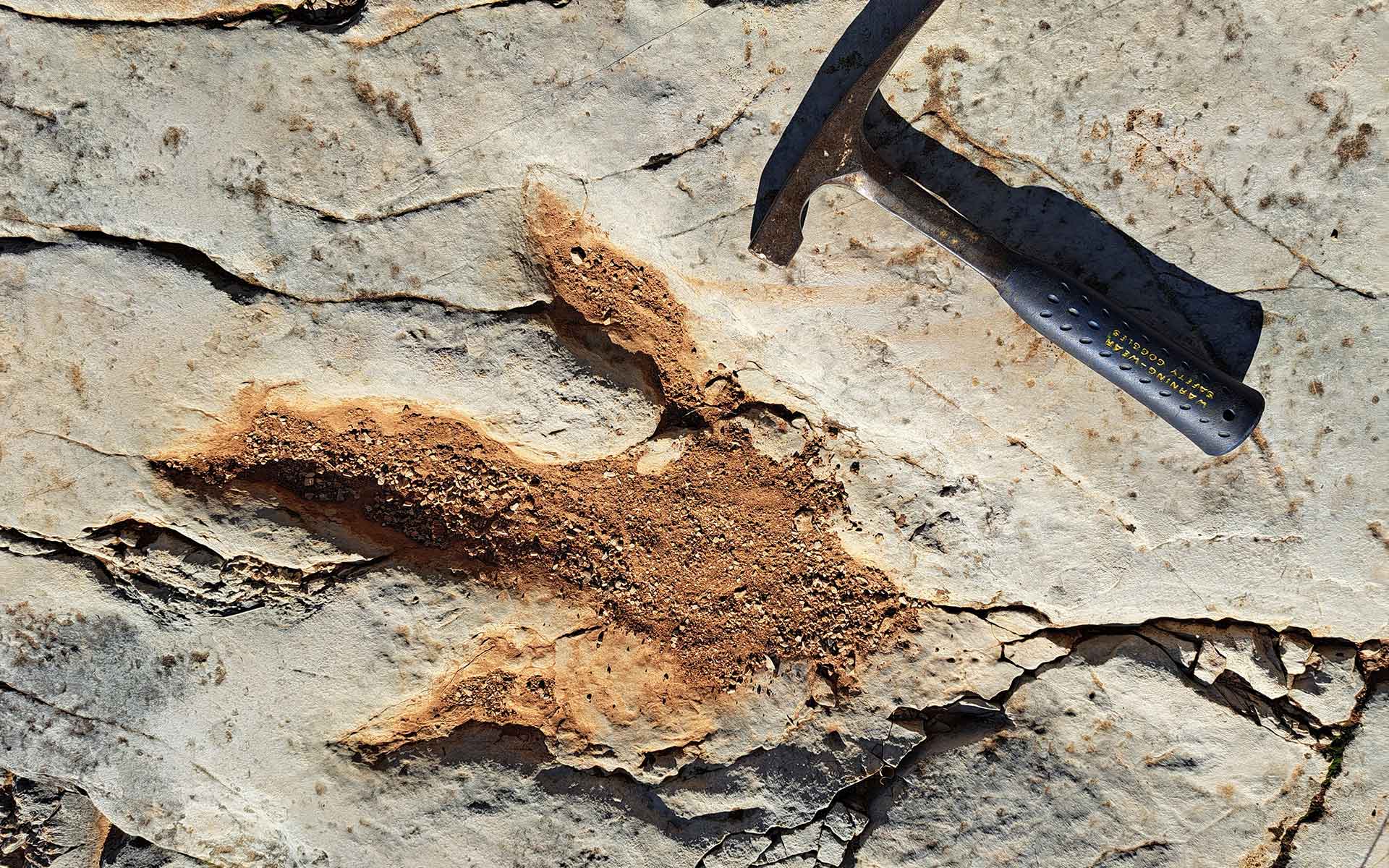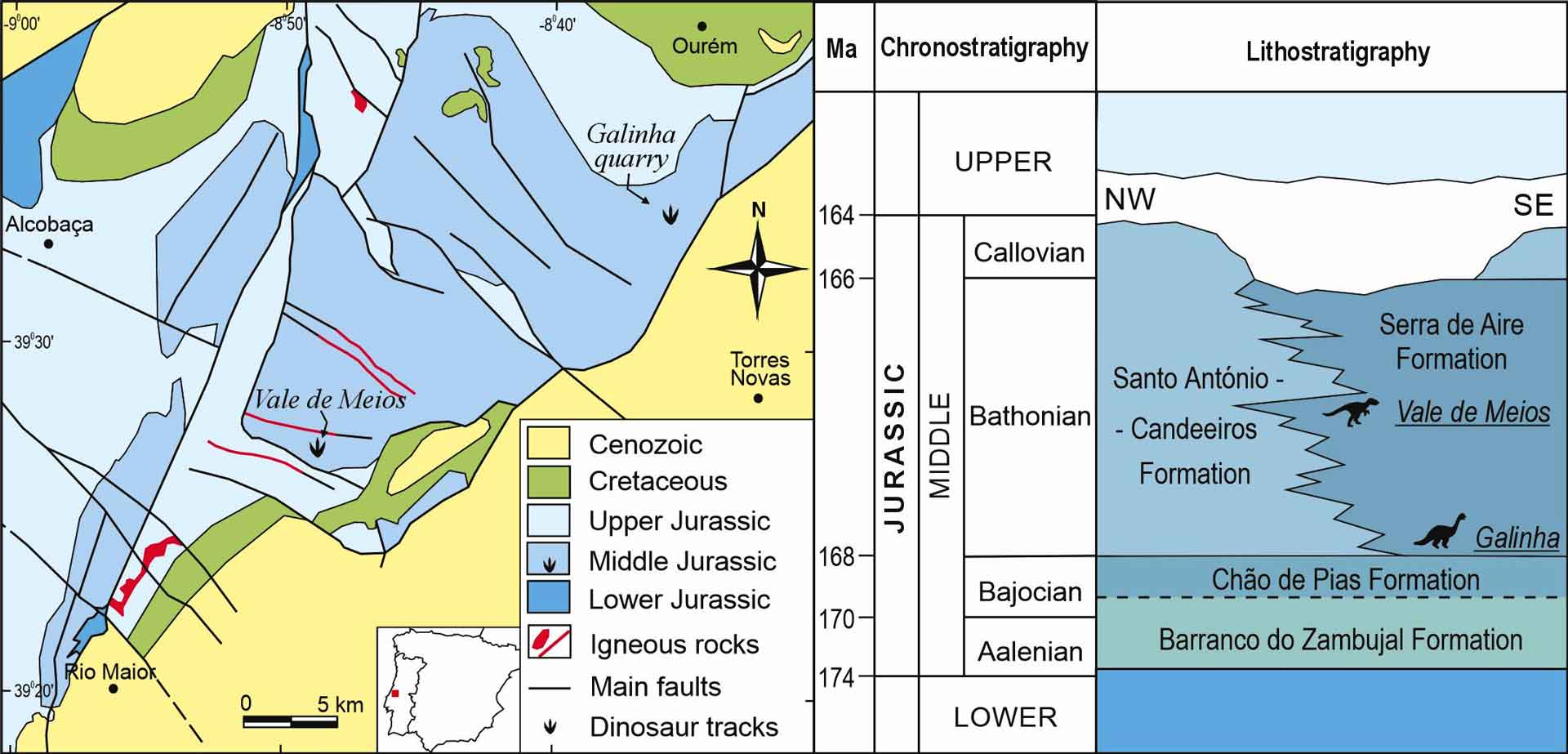Middle Jurassic dinosaur footprints from the Serras de Aire and Candeeiros
Portugal

Panoramic view of the Galinha quarry with the main sauropod trackways.
Geological Period
Middle Jurassic
Main geological interest
Paleontology
Stratigraphy and sedimentology
Location
Serras de Aire e Candeeiros Natural Park, Portugal
39°34’11”N, 008°35’21”W
Panoramic view of the Galinha quarry with the main sauropod trackways.
The longest and best preserved trails of dinosaur footprints in the Middle Jurassic
These quarries constitute a world-class Serial Site for understanding some of the oldest paleoenvironmental and paleoethological interactions involving sauropods and theropods. The ichnites of the Galinha quarry, with oval pes prints and speech-bubble-shaped manus prints (Castanera et al., 2016), have provided an important contribution to the knowledge of sauropods at an early stage of their development. It was even possible to describe Polyonyx gomesi as a new sauropod ichnotaxon (Santos et al., 2009). Vale de Meios quarry, is one of the most important sites with Middle Jurassic theropod tracks. The occurrence of Megalosauripus tracks represents the oldest occurrence of this ichnotaxon (Razzolini et al., 2016).
- Geological description
The Dinosaur Footprints Natural Monument of Ourém/Torres Novas, known as Galinha quarry, and the Vale de Meios quarry, are located in the Serras de Aire e Candeeiros Nature Park (Central Portugal). They are two geosites, duly geoconserved, of recognized international scientific value, due to the exceptional age, size, and quality of preservation of ichnites. Both quarries are located in limestones of the Serra de Aire Formation (Bathonian, Middle Jurassic) (Azerêdo, 2007). The Galinha quarry preserves 20 trails with sauropod footprints, in an excellent state of conservation, and it is possible to observe finger marks and a ridge formed by the sediment that was removed under the weight of the animal. This deposit has some of the oldest and longest sauropod tracks known in the world (up to 147 m long), which provide a dynamic image of the locomotion of these sauropods (Santos et al., 2009). The Vale de Meios quarry preserves more than 700 theropod tracks. They are organized in at least 80 unidirectional trackways, arranged in a bimodal orientation pattern (W/NW and E/SE). Paleoenvironmental studies in this quarry indicate an inter-tidal flat located at the margin of a coastal barrier (Razzolini et al., 2016).
- Scientific research and tradition
Discovered and studied since the 1990s, multiple scientific studies have been carried out on these dinosaur track sites (Santos, 2016), involving several international researchers. Similarly, since their discovery attracted educational and tourist visits, from nationals and foreigners, they are currently duly protected and equipped for that purpose.
- Reference
Azerêdo, A. (2007) ‘Formalização da litostratigrafia do Jurássico Inferior e Médio do Maciço Calcário Estremenho (Bacia Lusitânica)’, Comunicações Geológicas, 94, pp. 29–51.
Castanera, D. et al. (2016) ‘Iberian sauropod tracks through time: Variations in sauropod manus and pes track morphologies’, in P. Falkingham, D. Marty, and A. Richter (eds) Dinosaur tracks – The next steps. Bloomington,: Indiana University Press, pp. 121–137. Available at: https://www.researchgate.net/publication/316516090_Iberian_sauropod_tracks_through_time_Variations_in_sauropod_manus_and_pes_track_morphologies.
Razzolini, N.L. et al. (2016) ‘Ichnological evidence of Megalosaurid Dinosaurs Crossing Middle Jurassic Tidal Flats’, Scientific Reports, 6(1), p. 31494. Available at: https://doi.org/10.1038/srep31494.
Santos, V.F. (2016) ‘Dinosaur tracksites in the Middle Jurassic of Maciço Calcário Estremenho (west-central Portugal): A geoheritage to be enhanced’, 103, pp. 55–58.
Santos, V.F. dos, Moratalla, J.J. and Royo-Torres, R. (2009) ‘New Sauropod Trackways from the Middle Jurassic of Portugal’, Acta Palaeontologica Polonica, 54, pp. 409–422. Available at: https://doi.org/10.4202/app.2008.0049.
- Author(s)
Luís Lopes.
University of Évora / ICT- Earth Sciences Institute. Portugal.
Artur Abreu Sá.
Department of Geology, University of Trás-os-Montes e Alto Douro, 5000-801 Vila Real, Portugal.
Jorge Carvalho.
LNEG – National Laboratory of Energy and Geology. Portugal.
Lia Mergulhão.
ICNF – Institute of Nature and Forest Conservation. Portugal.
Mário Cachão.
University of Lisbon / IDL – Dom Luiz Institute. Portugal.
António Galopim de Carvalho.
University of Lisbon. Portugal.


